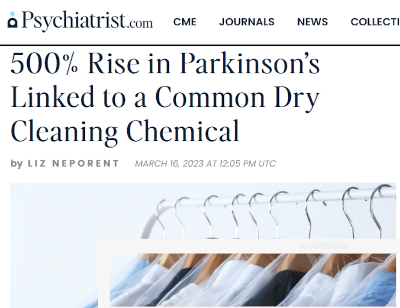Industry slammed in false media stories

They’re at it again!
There’s been an upswing in the number of articles appearing in the mainstream media in recent days talking about the apparent link between TCE (Trichloroethylene) contamination and the incidence of Parkinson’s disease. Some of these articles casually toss in a statement like, “The solvent is used to degrease engine parts, in industrial settings, and in dry cleaning.” Inaccurate and sensational headlines like the one pictured above can cause your customers to ask questions. Are you ready for that?
The article that triggered the current interest was published in the May 15, 2023 Journal of the American Medical Association’s Neurology issue. In it, a study was done by a California university in which over 300,000 soldiers were tracked over decades to determine the impact of TCE exposure. Two bases were studied: Camp Lejeune, which is noted for its TCE contamination, and a California based that was not contaminated. The results showed a far greater incidence of Parkinson’s among those at Camp Lejeune than the other base.
Why the hullabaloo?
To understand the resurgence in interest on this topic, you need to understand how reporters think. Their goal is to get their articles in print, or their reports on line or in other media. That means they seek a common denominator that will strike a chord with the most people and get them to read/watch the story.

In the case of the TCE/Parkinson’s link, there’s a ready-made interest because Parkinson’s is an admittedly terrifying disease. Nobody wants it. It is incurable to date, and devastating in its impact. But to further drive story engagement, they need something that links the potential of Parkinson’s to the greatest number of people.
Obviously, saying TCE is used to clean machine parts doesn’t exactly grab attention. But link it to dry cleaning, something many people use on a regular basis, and you have the formula for a winning story. It’s unfortunate that the link is inaccurate, but that is not always brought out in news stories.
Let’s get it straight
Trichloroethylene (TCE) and perchloroethylene, or perc, (sometimes called tetrachloroethylene in scientific documents) are not the same thing. Though both are used as degreasers and TCE was formerly used in dry cleaning (many decades ago), when TCE was phased out as a possible risk for cancer, many dry cleaners moved to perc (PCE).

Chris Tebbs of the International Drycleaners Congress (and many other organizations) went so far as to send us the chemical formulae to show they are different:
Trichloroethylene: C2HCl3
Perchloroethylene: C2Cl4
‘Close, but Trike (TCE) has one less chlorine molecule and an additional hydrogen molecule,’ he said. ‘It is certainly over 25 years since I heard of anyone using Trike in our industry—certainly, machines to dry clean in Trike have not been around for more than 40 years.’ He added that TCE is still used for cleaning automotive engines, particularly in countries such as China.
Beginning in the 1990s, users of perc in dry cleaning moved to closed-loop systems, in which perc is delivered in barrels, transferred to machines without open pouring, and then recycled into the barrels again for proper disposal. This is an entirely different situation than in the 1970s and 1980s, which is when the soldiers at Camp Lejeune were exposed to TCE (not perc!)

Jon Meijer at the Drycleaning & Laundry Institute (DLI) gave more information on TCE use in the industry.
‘Chlorinated Hydrocarbons, including TCE and Perc, were developed in the 1930s. It wasn’t until the 1970s that TCE and Perc became available for use in dry cleaning. However, even in the 1970s, there were less than 50 machines in operation in the U.S., with a demographic of nearly 40,000 cleaners at that time,” he said.
‘To the best of my knowledge, the U.S. Envionmental Protection Agency (EPA) never mentions TCE with regard to dry cleaning solvents. What does happen is that media outlets confuse TCE for PCE (Perc) and assume they are one in the same. This has continued to cause confusion and we still receive calls from time to time, including from government agencies.’
Talking to customers
If customers ask questions about these reports, you need to be the expert they can depend on to give them accurate, clear and reassuring information. There are several things you can say.
- If you are using a solvent other than perc (GreenEarth, K4, hydrocarbon, Sensene, wet cleaning), you can simply inform them that you use a different process and solvent. Don’t go down the ‘trashing perc’ road (‘We use something environmentally friendly, not that nasty perc stuff!’) but rather talk about the positives of your system.
- If you use perc, let them know it is not the same as the solvent being spoken of in the articles. State that TCE has not been used by dry cleaners in decades. Talk up the incredible amount of environmental regulation that applies to perc today, the use of closed-loop delivery systems and recycling of used solvent, and the fact that you use the latest, safest equipment.
- Above all, thank your customer(s) for their environmental awareness and concern. Tell them you share it. You live in their community, wear garments cleaned by your equipment, and are continually educating yourself in the latest information about cleaning processes and their impact on the environment and personal health.

In other words, your role is not to overload them with technical data, but rather to give them clear answers about why what you use is different from the solvent they are concerned about. Offer to take them on a tour of your plant (make sure it’s clean, please) and show them the fabulous equipment you use and the craftspeople who are using it every day.
Turn a potentially negative situation into a positive one by educating the customer. There’s a good chance they’ll feel empowered by what they’ve found out, and tell others what they learned and saw. They’ll be the best spokespeople for the industry we could possibly have.
Additional information:
Health & Safety Overview of Tetrachloroethylene (PCE, PERC) & Trichloroethylene (TCE)
The History of Dry Cleaning Solvents and the Evolution of the Dry Cleaning Machine







